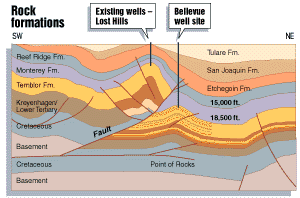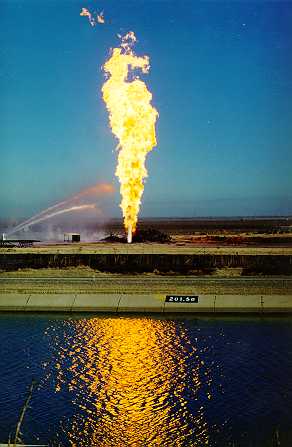Famous Gushers of California
click any picture below for a larger view
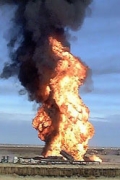 A "gusher" is an oil well that rages out of control, sending a column of oil into the sky. The British called them "spouters", and to the Russians they were "fountains". The official term seems to be "blow out", at least in the technical journals. All of the early oil regions - Baku, Pennsylvania, Romania/Poland, Texas, and California - had gushers, and the locals in all these areas, at one time or another, tried to lay claim to the title of having the world's greatest gusher. What follows is a sampling of some of the more famous gushers. This page looks at Famous Gushers of California, but there is also a page on the other Famous Gushers of the World.
A "gusher" is an oil well that rages out of control, sending a column of oil into the sky. The British called them "spouters", and to the Russians they were "fountains". The official term seems to be "blow out", at least in the technical journals. All of the early oil regions - Baku, Pennsylvania, Romania/Poland, Texas, and California - had gushers, and the locals in all these areas, at one time or another, tried to lay claim to the title of having the world's greatest gusher. What follows is a sampling of some of the more famous gushers. This page looks at Famous Gushers of California, but there is also a page on the other Famous Gushers of the World.
Ventura Basin - The first gusher in California was the Adams No. 16, a well in the Adams Canyon part of Santa Paula field in the Ventura basin. This well spouted over the top in January 1888, barely two miles from the Santa Paula post office, with a flow of 500 barrels a day. The No. 16 was followed in February, 1892 by the even bigger Adams No. 28, also known as the "Wild Bill", which flowed out of control at about 1,500 barrels per day to send torrents of oil down the Santa Clara River and out to sea. Drilled by the Hardison and Stewart Oil Company, a predecessor of the Union Oil Company of California, these two wells demonstrated to the world the huge potential of the California oil fields.
McKittrick - The first truly big gusher in the southern San Joaquin Valley (Kern County) was a Klondike Oil Company well called the Shamrock Gusher, which came in at 1,300 barrels a day in 1896. The Shamrock gusher signaled the end of tar mining operations in Kern County and heralded the rapid ascendancy of the San Joaquin Valley to the most prolific oil province of California.
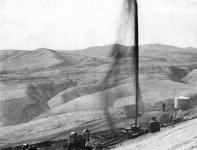
 Coalinga - The Shamrock gusher was followed by a well at Coalinga, in the northern San Joaquin Valley (Fresno County), named the Home Oil Company No. 3. Sometimes called the "Blue Goose" gusher, this well blew out in the Oil City area of the field in 1898 at 700 to 1,000 barrels of oil per day. It was followed in the southernmost part of the field in September, 1909 by the Silvertip No. 1 gusher, which flowed out of control at the phenomenal rate of 10,000 to 20,000 barrels per day. One local newspaper called the Silvertip that "greatest gusher ever developed in the state", but that title was take away just a few months later when the Lakerview Gusher came in.The upper left picture is the Blue Goose Gusher, and the upper right one is the Silvertip.
Coalinga - The Shamrock gusher was followed by a well at Coalinga, in the northern San Joaquin Valley (Fresno County), named the Home Oil Company No. 3. Sometimes called the "Blue Goose" gusher, this well blew out in the Oil City area of the field in 1898 at 700 to 1,000 barrels of oil per day. It was followed in the southernmost part of the field in September, 1909 by the Silvertip No. 1 gusher, which flowed out of control at the phenomenal rate of 10,000 to 20,000 barrels per day. One local newspaper called the Silvertip that "greatest gusher ever developed in the state", but that title was take away just a few months later when the Lakerview Gusher came in.The upper left picture is the Blue Goose Gusher, and the upper right one is the Silvertip.
 Santa Maria - The first and biggest of several spectacular gushers in Santa Maria field, on the California coast, was the Union Oil Hartnell No. 1, known to most as "Old Maud", which went over the top in 1904 and flowed 12,000 barrels of oil a day for the next three months. Old Maud blew for two more years and ultimately produced 3 million barrels of oil.
Santa Maria - The first and biggest of several spectacular gushers in Santa Maria field, on the California coast, was the Union Oil Hartnell No. 1, known to most as "Old Maud", which went over the top in 1904 and flowed 12,000 barrels of oil a day for the next three months. Old Maud blew for two more years and ultimately produced 3 million barrels of oil.

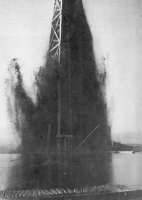
Midway-Sunset - The 1896 success of the Shamrock gusher in the southern San Joaquin was followed in November, 1909 by the Chanslor-Canfield Midway No. 2-6, simply called the Midway Gusher, which blew out near the oil town of Fellows. Flowing at about 2,000 barrels of per day, this well foreshadowed development of Midway-Sunset, a billion-barrel field that today is the largest oil-producing field in the contiguous United States.
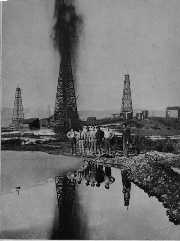 Lakeview - Spectacular as the Midway gusher was, it was dwarfed by Lakeview No. 1, located only 12 miles to the southwest, which started flowing, uncapped and untamed, on the morning of March 15, 1910. The Lakeview gusher initially flowed as much as 125,000 barrels of oil per day, and flowed at 15,000 to 90,000 barrels a day for the next two months. Unequaled in the United States to this day, Lakeview flowed unabated for 18 months and produced an estimated 8.2 million barrels, only half of which was ultimately saved and sold. Click here to learn more about the Lakeview Gusher.
Lakeview - Spectacular as the Midway gusher was, it was dwarfed by Lakeview No. 1, located only 12 miles to the southwest, which started flowing, uncapped and untamed, on the morning of March 15, 1910. The Lakeview gusher initially flowed as much as 125,000 barrels of oil per day, and flowed at 15,000 to 90,000 barrels a day for the next two months. Unequaled in the United States to this day, Lakeview flowed unabated for 18 months and produced an estimated 8.2 million barrels, only half of which was ultimately saved and sold. Click here to learn more about the Lakeview Gusher.
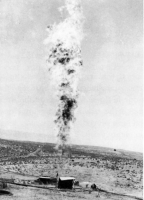
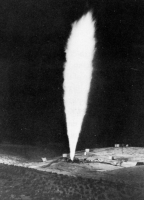
Elk Hills - The greatest gas well in the United States was the Standard Hay No. 7 at Elk Hills, a field that was formerly the U.S. Naval Petroleum Reserve No. 1. Foreshadowed by several nearby blowouts, Hay No. 7 blew out and caught fire on July 26, 1919, flowing 50 million cubic feet (MMCF) of gas per day. The well created a spectacular pillar of flame that shot high into the air and burned out of control for 26 days until the flame was extinguished with dynamite. Capped at an estimated rate of 140 MMCFD, this great well produced 43 billion cubic feet of gas over the next 7 years.
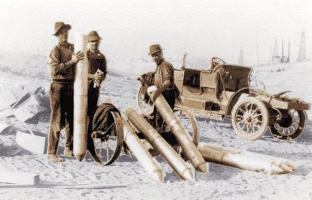
Preparing torpedos of dynamite to extinguish a burning well.
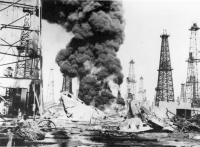 Los Angeles - The Shell Alamitos #1 well was a short-lived gusher that flowed 590 BOPD on Signal Hill near Long Beach, California on June 25, 1921. This well marked the discovery of one of the most productive oil fields in the Los Angeles basin. Throughout the 1920s Signal Hill, and nearby Santa Fe Springs field, had many blowouts that erupted into spectacular pillars of flame, visible for miles around. These disasters ultimately led to demands for state-enforced safety measures, with the result that blow-out prevention equipment became mandatory in 1929 on all wells drilled in California. The picture below shows an early gusher at Signal Hill. The actual hill that the field is named for is visible in the background and represents the surface expression of an anticline. The picture in the upper right shows a well fire that resulted from one of the many blowouts at nearby Santa Fe Springs field during the 1920s.
Los Angeles - The Shell Alamitos #1 well was a short-lived gusher that flowed 590 BOPD on Signal Hill near Long Beach, California on June 25, 1921. This well marked the discovery of one of the most productive oil fields in the Los Angeles basin. Throughout the 1920s Signal Hill, and nearby Santa Fe Springs field, had many blowouts that erupted into spectacular pillars of flame, visible for miles around. These disasters ultimately led to demands for state-enforced safety measures, with the result that blow-out prevention equipment became mandatory in 1929 on all wells drilled in California. The picture below shows an early gusher at Signal Hill. The actual hill that the field is named for is visible in the background and represents the surface expression of an anticline. The picture in the upper right shows a well fire that resulted from one of the many blowouts at nearby Santa Fe Springs field during the 1920s.
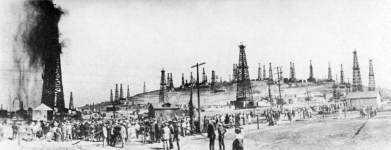
 Offshore California - Despite blow-out prevention equipment, well number 5 on Union Oil Platform A over the offshore Dos Cuadros field blew out on January 28, 1969 and spilled 80,000 to 100,000 barrels of oil into the Santa Barbara channel, fouling beaches and wildlife. This disaster ultimately led to State and Federal bans on offshore drilling in California that remain in force today. The thumbnail on the left shows oil and gas from the blow out bubbling up through sea water around the rig.
Offshore California - Despite blow-out prevention equipment, well number 5 on Union Oil Platform A over the offshore Dos Cuadros field blew out on January 28, 1969 and spilled 80,000 to 100,000 barrels of oil into the Santa Barbara channel, fouling beaches and wildlife. This disaster ultimately led to State and Federal bans on offshore drilling in California that remain in force today. The thumbnail on the left shows oil and gas from the blow out bubbling up through sea water around the rig.
 Lost Hills - The Bellevue Resources Bellevue No. 1 (17-26S-21E), a wildcat well drilled into the subthrust beneath Lost Hills field (see the cross-section below) blew out at a depth of 17,657 feet and erupted into flame on the evening of Monday, November 23, 1998. The well burned high-pressure condensate from the Temblor Formation at estimated rates of 40 to 100 million cubic feet (MMCF) of gas per day for 14 days - fueling hopes for the first major San Joaquin basin discovery in over a decade. (Click the picture of the Bellevue blowout on the above right for a better view of this wild well.)
Lost Hills - The Bellevue Resources Bellevue No. 1 (17-26S-21E), a wildcat well drilled into the subthrust beneath Lost Hills field (see the cross-section below) blew out at a depth of 17,657 feet and erupted into flame on the evening of Monday, November 23, 1998. The well burned high-pressure condensate from the Temblor Formation at estimated rates of 40 to 100 million cubic feet (MMCF) of gas per day for 14 days - fueling hopes for the first major San Joaquin basin discovery in over a decade. (Click the picture of the Bellevue blowout on the above right for a better view of this wild well.)
Amazingly, no rig personal were hurt when the well "took a kick", erupted into flame within minutes, toppled the rig, and melted the rig, mud log trailer, and everything else on the well site. The flame shot as tall as 300 feet and was visible 40 miles away. Even Boots and Coots Well Control Specialists, despite their experience extinguishing well fires in Kuwait after the Gulf War, couldn't extinguish the fire.















